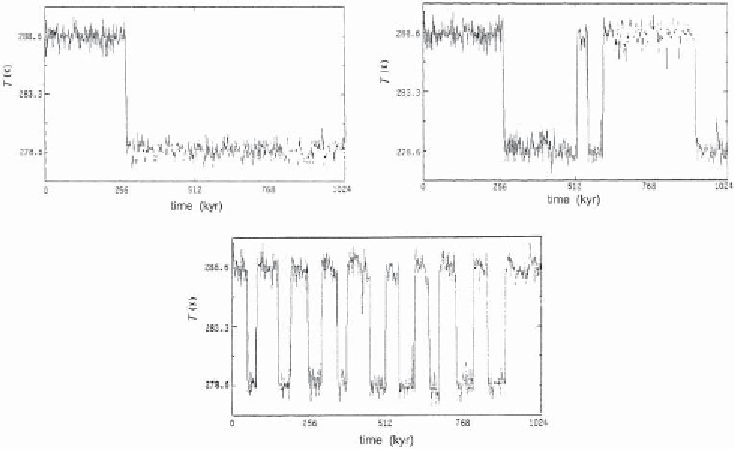Environmental Engineering Reference
In-Depth Information
(b)
(a)
(c)
Figure 4.28. Numerical simulation of the dynamics expressed by Eq. (
4.73
) with
(a) stochastic forcing but no periodic driver (i.e.,
s
gn
=
0), and no
stochastic resonance is observed; (b) weak stochastic forcing and periodic driver
(i.e.,
s
gn
=
0
.
01 and
a
=
10
−
4
), and no stochastic resonance is observed;
(c) stronger stochastic forcing and periodic driver (i.e.,
s
gn
=
0
.
025 and
a
=
0
.
5
×
×
10
−
4
), and in these conditions stochastic resonance emerges. Taken from
Benzi et al.
(
1982b
).
0
.
05 and
a
=
0
.
5
V
max
π/ω
maximum
with a period 2
. Stochastic resonance occurs when the noise
2
,
3
level (i.e., the intensity
s
gn
of
ξ
gn
) is strong enough to allow for the occurrence
of transitions when the potential barrier has minimum height, but not when it is
maximum (otherwise the periodic forcing would not be able to regularize the timing
of these occurrences). The first condition is met when the value of
t
c
2
,
3
calculated
V
min
with
is close to the semiperiod
π/ω
, whereas the second condition requires
2
,
3
that, when
V
2
,
3
is maximum, the mean crossing time
t
c
2
,
3
be longer than the
period 2
. For the parameters reported in this subsection (see
Benzietal.
,
1982b
)
stochastic resonance occurs when the intensity
s
gn
of the additive noise is contained
within the interval 0.03 K
2
yr
−
1
π/ω
07 K
2
yr
−
1
. Figure
4.28
shows some
examples of time series generated by this model with different values of
s
gn
.In
the case of Fig.
4.28
(a),
s
gn
is by far below the lower end of this interval; in these
conditions no transition occurs. In the case of Fig.
4.28
(b),
s
gn
is slightly smaller than
the lower minimum value of the interval; we observe that some transitions occur but
they do not exhibit a well-defined periodicity. In this case noise is too weak to induce
order in the timing of these occurrences (i.e., for stochastic resonance to occur). For
<
s
gn
<
0
.

Search WWH ::

Custom Search